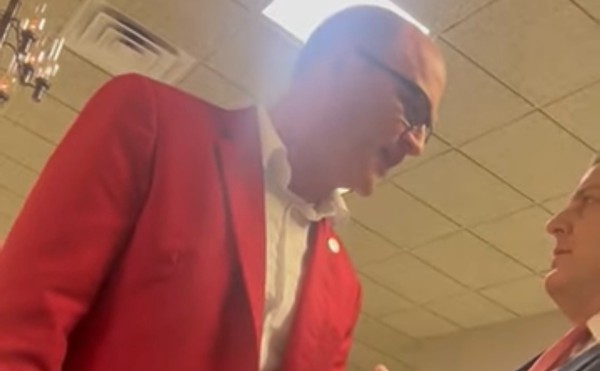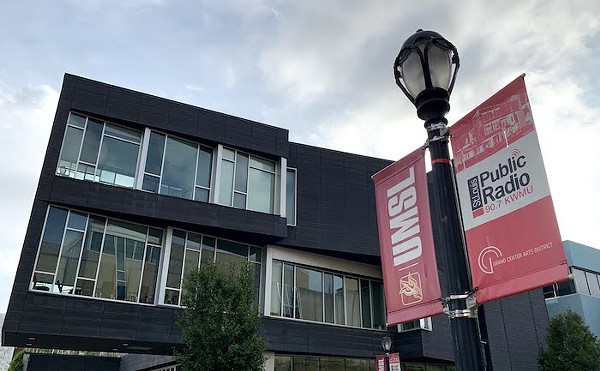In one corner of the room a lady is spotted tickling a cutout of Hulk Hogan's mustache. She's leaning against it, posing glassy-eyed for a photograph.
Welcome to the 'Stache Bash, an annual affair hosted by the St. Louis-based American Mustache Institute. Total membership: Eight. If you don't have a mustache, organizers are only too happy to provide one for you.
Some 1,000 people have bucked up a $25 cover charge this October night to pay homage to the mustache. At 9:30 p.m., Aaron Perlut, the director of the three-year-old Institute, bounds onstage in floppy yellow shoes and a tuxedo top. Perlut's brother and dad are both wearing lab coats and stethoscopes — the standard uniform, one reckons, for mustacheologists.
"We are a facial-hair advocacy group," he tells the crowd. His deadpan explanation summons a smattering of applause.
Perlut proceeds to invite Joy L. Robinson, a public-relations manager, onto the stage. "On behalf of Just For Men, I'd like to present you with a $5,000 check," she says, a donation that will go to the St. Louis chapter of Challenger Baseball, a league for children and adults with disabilities.
As part of their sponsorship of the 'Stache Bash, Just for Men provided mustache-coloring kits for the faux mustaches that are displayed on tables around the room. They also paid to fly in the Robert Goulet Memorial Mustached American of the Year award winner, Tim Galvin, who began growing his mustache after graduating from a strict Catholic school in 1974 — and hasn't shaved it since.
Voters were especially moved by his life story. During his twenty-plus years of police service, Galvin earned medals of valor after being shot twice, in the face and leg, while working undercover in February 1997. "If I was a cat I would have gone through eight of the nine lives," he says as he accepts the award, a purple crown that he places on top of his head.
A short history of the mustache is in order. Let's begin with last year's Academy Awards ceremony that saw a number of actors with mustaches collect nominations: Daniel Day-Lewis, Josh Brolin, Philip Seymour Hoffman. Things like that get the mustache community plenty excited. These are people who pin Mustache Day proclamations on walls and grab their hearts at the mention of Tom Selleck shaving off his lip sweater.
"We always have this concept of the mustache clock," says Dan Callahan. "Midnight was 1972. Right now, we think we're five minutes to twelve. It's so out of fashion that it's becoming cool to grow one."
The arrival of the English mustache, in 1920s melodramas, started to cast the facial frosting in a villainous light; the top hat and cape only made things worse. Wall Street tycoons wore mustaches, but so did trust-busting Theodore Roosevelt a few years earlier. Adolf Hitler, of course, made the thin mustache infamous after he went goose-stepping around the world.
After a dry spell that lasted until a rich harvest of hair made a comeback in the 1960s, Burt Reynolds arrived as the consummate mustache celebrity. He made them popular for all the right reasons, strutting around as Bo "Bandit" Darville in Smokey and the Bandit.
Rollie Fingers, who spent most of his baseball career with the Oakland Athletics, delighted fans with the curly tips at the end of his mustache. Ex-Cardinal Keith Hernandez is a champion mustache-grower. In fact, in 2007, Hernandez beat out Yankee great Don Mattingly in the AMI sports-mustache competition.
In the African American community, the mustache has had a more stable ride. Martin Luther King Jr. wore one, and years later so did Michael Jordan, even in the clean-shaven 1980s and 1990s.
"Today, you are more likely to see the mustache in rural America than urban America," observes Callahan. "It can be perceived to be redneck."
There is no way anyone at Fleishman-Hillard, the public-relations firm where Aaron Perlut works, could have recognized the significance of the offhand remark Tony Zagora made one day three years ago.
"We should really bring back the mustache," Zagora joked to a few of his colleagues. They were intrigued, but no one more so than Perlut and Callahan. Zagora says his observation came at a time when mustaches were popping up everywhere, most noticeably in movies such as Anchorman.
"The idea developed into something that has kind of steamrolled," he says. "Once we built it up a little more, we thought it could be a cool thing to do for charity and would give us an excuse to grow one."
Perlut remembers organizing a meeting with a few of the guys during lunch at the office a few weeks later. "Every couple of weeks we started talking about putting together an event that would become the first 'Stache Bash," he says.
"By year two we decided we needed to create some kind of organization to build it around. Then we built the website in July 2007. That's also when we started organizing beatings of the clean-shaven," Perlut jokes.
Links on blogs and comedy websites have been the biggest boon for the Institute: Google "mustache" and the website www.americanmustacheinstitute.org appears no lower than second. But the club struck gold with the "best sports mustache of all time" competition in the summer of 2007, notes Callahan. "Little did we know we were on the cusp of this change," he says.
This past summer, there was a campaign to get Jason Giambi on the All-Star team based solely on the merits of his mustache, and Perlut subsequently appeared on ESPN to talk facial hair.
And last December the Institute intervened when a student was asked to shave his mustache in keeping with school policy in Royse City, Texas. After exchanging e-mail with the student and school administrators, Perlut sent an e-mail to Royse City Schools superintendent Randy Hancock.
"It wasn't a matter of whether I cared that kids had mustaches or not; the guidelines were in place," Hancock explains. He says the standards were later changed by a committee that oversees the school's dress code.
Not that he has anything against mustaches.
"I'm sitting here with a mustache right now," he says during a phone interview.
Most recently, a news story about an Ohio police officer who's been suspended for the girth of his mustache is drawing attention. The Institute sent an e-mail protesting the decision to officials in Sylvania Township, Ohio.
"Indeed, one of our inalienable rights as Americans is the freedom of expression as long as it does not pose a safety threat to our fellow citizens," the e-mail read. "But despite this, the Mustached American people have faced grave discrimination in this nation, as so few of us find our ways into positions of authority or leadership outside law enforcement."
Three responses to the e-mail have already been posted on the website. One comment was from a township trustee.
Despite the attention, no empirical evidence suggests that Americans are growing more mustaches these days. Still, Dave Devine, manager of the American Classic Barbershop on Chippewa Street, says he does notice more customers with "trucker-style and Fu Manchu" designs. "If I had to guess, some rock band somewhere was sporting one."
Perlut says the 'Stache Bash raised $15,000 this year for Challenger Baseball. This month kicks off Movember, a prostate cancer fundraiser in which people grow their mustaches for cash.
"We raised $21 million last year. It is the biggest prostate cancer fundraiser globally," says Adam Garone, the CEO and founder of Movember.
Some 130,000 people from the United States, Australia and beyond registered to participate. Garone said the goal this year is to have anywhere from 250,000 to 1 million people take part.
"I think there are a lot of guys out there who secretly want to know what they would look like with a mustache," he says. "It's an underground movement and it is a bit antiestablishment. We often get people who say Movember is a little like Fight Club."
Just ask Denny Rogers about the 'stache's most glorious decade. The St. Louis resident has maintained his traditional bushy mustache for 36 years. He started growing it in 1972, when he was a military policeman in Vietnam.
"It just kind of fit the image," he explains between sips of coffee at a south St. Louis Steak 'n Shake. Rogers was one of the sixteen finalists for the Robert Goulet contest. The competition included such celebrities as Jason Giambi, Art Monk, Pat O'Brien and Libertarian candidate Bob Barr, the first mustached candidate to seek the presidency since Thomas Dewey in 1948.
Rogers says his most trying mustache-related ordeal occurred in the disco decade, when he applied for a union job at a smelt-iron plant in Glover, Missouri.
"I couldn't believe the harassment in that 90-day period," he says, shaking his head. His mustache came to epitomize the struggle between union and nonunion power.
Jon Alvarez is possibly the most practical mustache-grower on the planet. A sergeant in the United States Army National Guard, Alvarez is currently serving in Baghdad. Although military guidelines usually dictate a bare upper lip, the Hannibal, New York, native says fitting in there requires a little decoration.
"My reason for growing my mustache is simply that my job with the Army requires me to get outside the gate every day to meet with Iraqis," he writes in an e-mail. "And since their men sport mustaches, it only made sense for myself and my team to grow them."
Maybe Sandusky, Ohio, resident Darren Draper should have been deployed to Iraq years ago. He says one of the reasons he eventually left the Army National Guard was because he got tired of shaving.
Draper's long, black, droopy mustache trumped ten other contestants' at the informal mustache competition at 'Stache Bash. When he received the loudest applause from the audience, host Jay Della Valle, the director of The Glorius Mustache Challenge, even mentioned Draper's inspirational journey to get there on a Harley-Davidson motorcycle. "He drove 500 miles from Ohio," exclaimed Della Valle. "He came here to win!"
As an engineer and designer, Draper says he is happy he doesn't have to conform to strict dress codes. Jobs with mustache restrictions are not for him. "I figure if they have that kind of attitude they aren't worth working for," he says, standing next to Gregory Givens, last year's champion, who nods in agreement.
Givens, a House Springs resident, says Draper shouldn't be surprised at the celebrity the title offers. "My wife and I went to Chicago, and the concierge at the hotel recognized me," he says, smiling beneath a behemoth, paintbrush-thick mustache.





